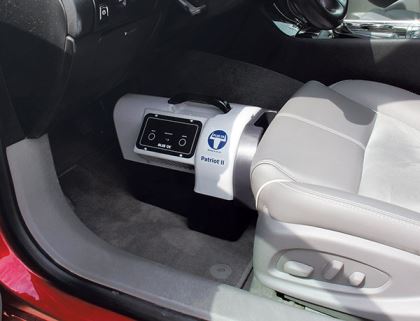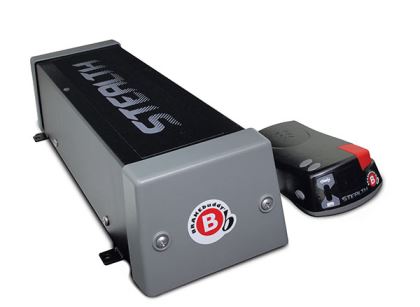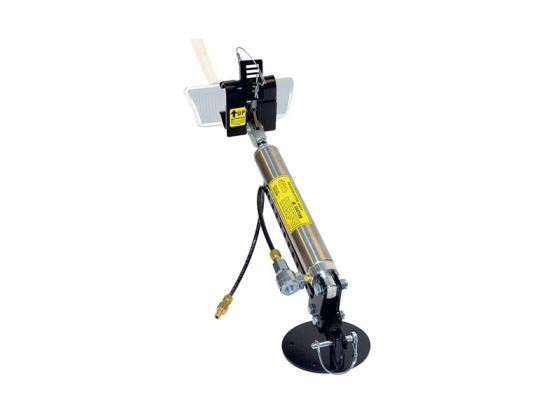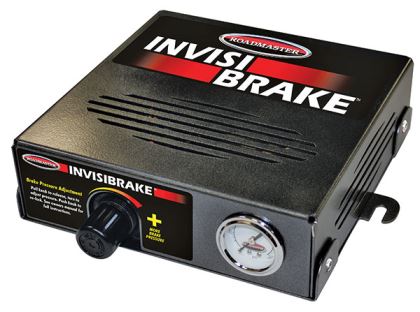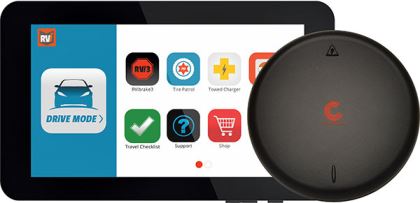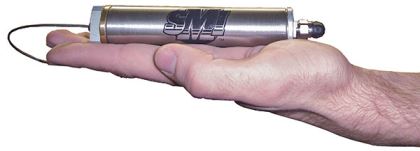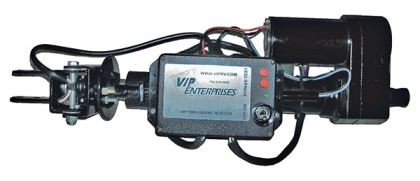Various supplemental braking products can provide the extra braking power needed by a motorhome and towed vehicle combination.
By Mark Quasius, F333630
October 2017
People who tow a vehicle behind a motorhome often raise questions about whether a supplemental braking system is necessary and the legality of towing without one. After all, the towed vehicle might be so light that you can’t feel it back there. But let’s be clear: If you tow a vehicle behind a motorhome, you should have a supplemental braking system. The facts bear this out.
A motorhome’s trailer hitch generally is rated at a maximum capacity of between 3,500 and 20,000 pounds, which is the weight it can safely handle without failing. But that doesn’t mean you can hook up any load and drive away, because the weight ratings of the motorhome itself must be taken into consideration.
Most owners are familiar with the term gross vehicle weight rating (GVWR), which is the maximum weight of the motorhome when fully loaded. However, the gross combination weight rating (GCWR) is more applicable when determining what can be towed. The GCWR includes the weight of the motorhome plus the weight of any trailer or towed vehicle.
Here’s an example: A motorhome with a GVWR of 32,000 pounds and a GCWR of 42,000 pounds will be able to tow up to 10,000 pounds, assuming that the coach does not exceed the GVWR and the hitch is rated for 10,000 pounds or more. The GCWR takes into account the ability of the engine and transmission to safely pull those extra 10,000 pounds, as well as the ability of the chassis to support it. But GCWR does not account for the ability of the motorhome brakes to stop that extra weight. Typically, the GCWR is based on the assumption that a trailer or towed vehicle has a supplemental braking system that will operate when the motorhome brakes are applied.
Laws that deal with supplemental braking systems vary by state and province. Some laws are written specifically for trailers, and may be hard to decipher when applied to towed vehicles. Regardless of legalities, any towed vehicle should have a supplemental braking system. It can make a difference during an emergency stop.
A Roadmaster Inc. braking test compared stopping distances for a 34-foot Type A motorhome traveling at 50 mph. The motorhome with no towed car required 132 feet to come to a complete stop. With a medium-size car connected, the stopping distance increased to 209 feet. When the towed vehicle had a supplemental braking system, the distance decreased to 137 feet. Those 72 feet can be the difference between stopping safely or having an accident.
A supplemental braking system also can offer protection during a breakaway situation. This feature is included in some braking systems and is an optional accessory in others, but a breakaway system always should be used. A breakaway system consists of a switch mounted on the towed vehicle and connected to the motorhome via a small steel cable. Should the tow bar fail during use or the towed vehicle become disconnected from the coach, the cable activates the breakaway switch; then the supplemental braking system applies the towed vehicle’s brakes to help bring the vehicle to a stop.
Even if the safety cables hold the vehicle behind the motorhome, damage still can occur. On one occasion, my wife and I were traveling on a two-lane highway when we heard a bang and felt a sudden jerk. The tow bar had failed, causing our Jeep to disconnect from the motorhome. I looked at the rear camera monitor and saw that the Jeep was pretty far back from the coach, being dragged by the safety cables. The breakaway switch had applied the Jeep’s brakes, so I was able to slow down and pull off the road. Without the supplemental braking system and breakaway switch, the Jeep would have struck the rear of the motorhome when I braked.
Every motorhome owner has different requirements, so there’s no one-size-fits-all answer. Some supplemental braking systems work better with diesel pushers with air brakes; some are better suited for gasoline-powered motorhomes without air brakes. Some systems are portable so they can be used on multiple towed vehicles, rather than permanently installed in one. If you plan to tow one specific vehicle, a permanent installation will be more convenient.
If you are handy, many supplemental braking systems can be installed as a DIY project. If you’re not comfortable doing it yourself, or if tapping into the motorhome’s air brake system is required, then an RV service technician can perform the installation.
Portable systems typically are placed on the floor in the driver’s area of the towed vehicle. A large push rod and clamp attach to the brake pedal. Generally, such systems are equipped with an accelerometer that senses when the unit slows down as the motorhome brakes are applied. The unit then applies pressure to the towed vehicle’s brake pedal. Typically, a 12-volt cord, plugged into a receptacle, supplies power. A breakaway switch must be mounted to the front of the vehicle, but the wiring, which remains in the vehicle, is linked to a plug-in connector that easily can be disconnected from the main unit. The benefit of portability is offset by having to set up and remove the unit before and after each use, storing the unit when not in use, and the tendency of some units to apply the towed vehicle’s brakes on downgrades because of the inertia sensors.
A surge brake system permanently attaches to the tow bar. The system senses the forward pressure of the towed vehicle during braking. As the module moves, it pulls on a steel cable that runs through the towed vehicle’s engine compartment to the area around the brake pedal. The cable attaches to the brake pedal and applies pressure to the pedal in response to the pressure applied to the tow-bar-mounted actuator.
Various systems are designed to be permanently mounted on the towed vehicle. Most require a fairly extensive installation process, but once in place, there is little, if anything, the operator needs to do when getting ready to tow. The systems may be electrically powered or driven by air pressure from a motorhome’s air brake system.
Gasoline-powered motorhomes don’t have air brakes, so electrically operated braking systems typically are used. An electric solenoid motor operates a steel cable or push rod that connects to the brake pedal. The solenoid can be controlled by inertia sensors or by a low-voltage signal sent from a controller mounted inside the motorhome. Some systems employ a hybrid method with inertia sensing in combination with a signal from the coach. The signal passes to the towed vehicle via one of the conductors in the six-wire trailer lighting umbilical cord.
The supplemental braking systems mentioned thus far also can be used with diesel-powered motorhomes equipped with air brakes. In addition, some systems are designed specifically to work with air brakes. An air hose connects to the motorhome’s air brake system and provides air to a module installed in the towed vehicle. The module proportionately applies the towed vehicle brakes in harmony with the motorhome brakes. This eliminates false signals from inertia sensors that may apply brakes on a downgrade when the coach is coasting or using the engine compression or exhaust brake. It’s also a simple connection; a quick-disconnect air hose connects the towed vehicle to the coach when you hook up the tow bar. Such systems require a bit more time to install but basically are hands-free afterward.
Following are summaries of many of the most popular braking systems. Manufacturers’ suggested retail prices are listed, but prices can vary depending on current sales and promotions.
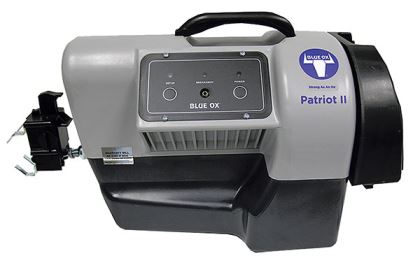 |
Patriot Brake II, a portable system, is placed on the floor of a towed vehicle in front of the driver’s seat and uses a push rod that clamps onto the brake pedal. An internal inertia sensor detects deceleration and applies the towed vehicle brakes accordingly. A breakaway switch is included. A wireless remote control in the motorhome cockpit monitors the Patriot’s status and can be used to apply the towed vehicle’s brakes manually if desired. The only installation required is for the breakaway switch and wiring. No pre-charging is required; once the system is plugged into a 12-volt source, it’s ready to go. $1,495.
Blue Ox, C2903* |
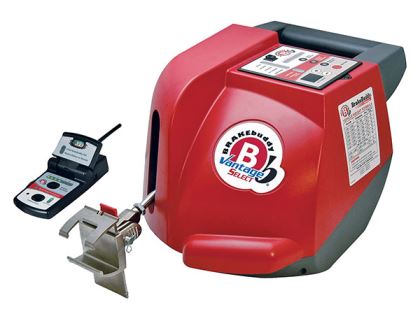
|
BrakeBuddy, introduced in 1996, was the first portable braking system.
BrakeBuddyDigital Classic and BrakeBuddy Vantage Select are portable systems that rest on the towed vehicle’s floor in front of the driver’s seat and connect to the brake pedal with a clevis. The units sense deceleration and apply the brakes accordingly. A breakaway switch mounts to the towed vehicle’s front bumper and wires run to the driver’s compartment. The breakaway and power cords plug into the system, making it easy to set up or remove. The Digital Classic’s price is $1,149. Vantage Select is a portable system with a one-touch start-up button. The system includes a wireless remote that can be placed in the motorhome cockpit, notifying the RVer with instant alerts from the braking unit. The user can choose between full or proportional braking, and can adjust the unit’s sensitivity for optimal braking performance. The Vantage Select’s price is $1,499. Brake Buddy Stealth consists of an electric motor unit that connects to the towed vehicle’s brake pedal via a cable. The unit can be mounted under the seat, in the trunk, or any other place that is out of the way. A dual controller, mounted in the cockpit of the coach, can be used to operate conventional electric trailer brakes, allowing you to tow a trailer or towed vehicle. The Stealth has a built-in breakaway system. $1,099. Hopkins Manufacturing Corp. |
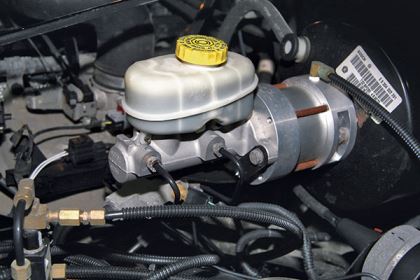 |
The M&G Car Braking System incorporates a patented air cylinder, mounted between the towed vehicle’s master brake cylinder and vacuum booster. It utilizes air pressure from a diesel-powered motorhome’s air brakes to provide true proportional braking by activating the brake master cylinder. The system deploys only when the coach’s service brakes are used. An optional breakaway kit includes a small air reservoir, solenoid valve, and breakaway switch. A quick-disconnect air line connects the towed vehicle’s braking system to the motorhome.
For motorhomes with hydraulic brakes, an optional power pack — including a 12-volt air compressor, an accumulator tank, and a proportioning valve — is available. The proportioning valve senses hydraulic brake pressure to determine the needed level of braking. The system for motorhomes with air brakes costs $640; the system for a coach with hydraulic brakes is $1,099. The price of the optional breakaway kit is $195. Some towed vehicles lack the space needed to mount M&G’s standard air cylinder. For those vehicles, the M&G 2.0 braking system is available. An air-operated cylinder mounts to a bracket that is installed under the towed vehicle’s hood. The cylinder connects to a cable that attaches to the floor behind the towed vehicle’s brake pedal. A 1/8-inch cable attaches to the brake pedal arm and applies the brakes. A heavy-duty automotive vacuum pump tees into a vacuum booster. A switch controls the vacuum pump and provides the towed vehicle with continuous vacuum-powered brakes during towing. The system for a motorhome with air brakes is $750; for a coach with hydraulic brakes, the cost is $1,199. The optional breakaway system is $195. M&G Engineering, C3896* |
 |
ReadyBrake is a true mechanical surge brake system that mounts in the hitch receiver in front of the tow bar. When the motorhome’s brakes are applied, the forward motion of the towed vehicle compresses a spring and a shock absorber inside the ReadyBrake. This activates an arm that connects a cable from the ReadyBrake to the towed vehicle’s brake pedal. The pressure applied to the towed vehicle’s brake pedal is the same as the pressure applied to the motorhome’s brake. Back pressure on ReadyBrake’s shock absorber prevents the towed vehicle’s brakes from being applied when driving down steep grades. The system requires no electrical connection other than a remote indicator lamp that can be located on the motorhome’s dash to inform the driver when the ReadyBrake is activated. After the initial installation, an adjustable sling cable is used to connect and disconnect the ReadyBrake. The price is $500. The price of an optional breakaway kit is $109.95.
NSA RV Products Inc., C8568* |
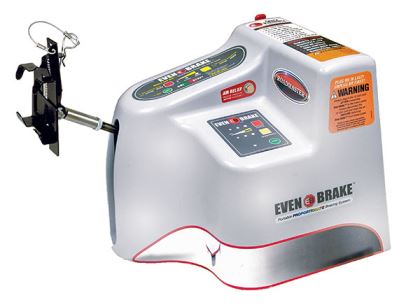
|
Even Brake is a portable system that automatically increases or decreases braking pressure in direct proportion to the motorhome. Even Brake rests on the towed vehicle’s floor; an air cylinder is connected to the brake pedal. Even Brake automatically delivers maximum braking pressure in an emergency or breakaway situation. A wireless monitor in the motorhome provides continuous braking information and system status, including the towed vehicle’s battery level. $1,537.
The 9700 is a basic portable system that applies a preset braking pressure — low, medium, or high. It also can be set to activate only in an emergency breakaway. The 9700 uses the towed vehicle’s electrical harness to brake with the motorhome; the same electrical signal that activates the towed vehicle’s brake lights also activates the 9700. An emergency breakaway system and an LED motorhome monitor are included. $1,209. BrakeMaster is a hybrid system. All of the permanently mounted components are hidden from view; an air cylinder is clamped to the brake pedal during towing. BrakeMaster connects directly to the motorhome’s braking system for true proportional braking — brake line pressure in the motorhome controls the brakes in the towed vehicle. The 9060 BrakeMaster is for motorhomes with hydraulic brakes; the price is $1,234. The 9160 is for motorhomes with air or air-over-hydraulic brakes; the price is $802. Both systems include an LED motorhome monitor and an emergency breakaway system. A seat adapter ($55.20) provides a vehicle-specific mounting location for the air cylinder, and may be required on some vehicles. InvisiBrake is a fully automatic, permanently mounted system that uses the motorhome’s brake-light signal to apply the towed vehicle’s brakes. InvisiBrake is hidden once installed, and requires no further adjustments. A controller, typically mounted in the passenger compartment, receives a brake-light signal from the motorhome. The vacuum created by the controller activates the power brakes, and an air cylinder pulls a cable that applies the brakes. InvisiBrake trickle-charges the towed vehicle’s battery while towing. An LED motorhome monitor and an emergency breakaway system are included. $1,081. Roadmaster Inc., C2952* |
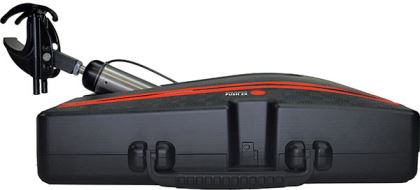
|
The RVibrake3 is a portable system that sets up in 30 seconds with the touch of a button. When it activates, the low-profile unit pushes against the towed vehicle’s solid floor pan, rather than the driver’s seat. An accelerometer detects changes in inertia during motorhome braking, and slope-sensing software prevents the system from being more sensitive when going downhill versus during a hard-braking situation. A 7-inch touch-screen wireless remote command center, which mounts in the motorhome, lets drivers engage brakes manually if desired. A breakaway system is included. Optional tire sensors can be added so the command center can be used to monitor tire pressures, with or without RVibrake in place. $1,195.
RVibrake |
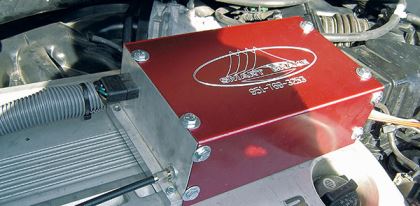 |
Smart Brake is a permanent-mount system designed by the inventor of the discontinued Unified Tow Brake. The system works with motorhomes that have either hydraulic or air brakes. The control module can be mounted anywhere but often is installed in the engine compartment. The module contains a vacuum pump that generates vacuum for the towed vehicle brake system’s power brake chamber. A shielded mechanical cable connects the control module to a bracket on the brake pedal. The system activates by a standard trailer brake controller mounted in the motorhome that feeds through the existing trailer brake wiring. The towed vehicle can be towed behind any motorhome equipped with a trailer brake controller, and the motorhome easily can switch between the Smart Brake-equipped towed vehicle or a trailer equipped with electric brakes. The Smart Brake connects to the coach via a standard seven-pin RV-style connector socket and umbilical cord, which are included.
UTB 1000 is a complete system, including a trailer brake controller; the price is $1,295. If you already have a trailer brake controller, the UTV 1000 is available for $1,095. UTH 1000 is for hybrid cars and does not include the vacuum pump; the price is $1,195. TVH 1000 is the same hybrid system as the UTH 1000 except it does not include the trailer brake controller; the price is $1,095. Smart Brake LLC, C12629* |
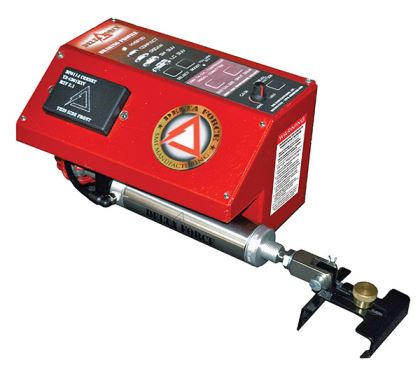
|
Air Force One, a permanently mounted system, uses air from the motorhome’s air brake system to provide direct proportional braking of the towed vehicle. The operating unit mounts under the hood of the towed vehicle. The brake actuator mounts to the brake arm of the towed vehicle and is secured to the firewall with one screw. An isolated air supply is created for the towed vehicle that protects the coach’s air brake system in the event of a breakaway or failure in the supplemental brake system. $1,249.95.
Stay-In-Play Duo is a permanent-mount supplemental braking system. The small operating unit is installed in the towed vehicle’s engine compartment. A compact actuator attached to the brake pedal arm operates the pedal. Two separate signals are required to activate the towed vehicle brakes — deceleration and motorhome brake lights. Immediate full braking power is applied during a panic stop. No wiring in the coach is required, except for an optional LED to indicate when the towed brakes are being applied. $1,099.95. Delta Force is a portable, proportional braking system. It can activate in inertia-only mode, or in dual-signal mode, which includes brake lights from the motorhome. A linear electric actuator connects to the main unit with a ball and socket. A clamp connects the other end of the actuator to the brake pedal. The actuator ram is attached to the firewall with a cable tether, so it does not rely on the driver’s seat for support. A remote, wireless monitor in the motorhome informs the driver of the status of the system at all times. A breakaway system is included. $1,195. SMI Manufacturing Inc., C7996* |

|
VIP Tow Brake uses a combination of the motorhome’s stop light signal and a braking inertia sensor to trigger automatic operation, which can be defeated if desired via a switch on the control module. The control module, mounted on the motorhome cockpit wall to the left of the driver, contains an accelerometer that determines the braking desired, as well as LED indicators to monitor the system’s status, and a manual braking button. The module also indicates if a breakaway occurs and applies the brakes accordingly. An electric actuator attaches to a base-mounted bracket and the brake pedal arm. The unit is easily removed for driving. $979.
VIP Enterprises Inc. |
*FMCA commercial member

